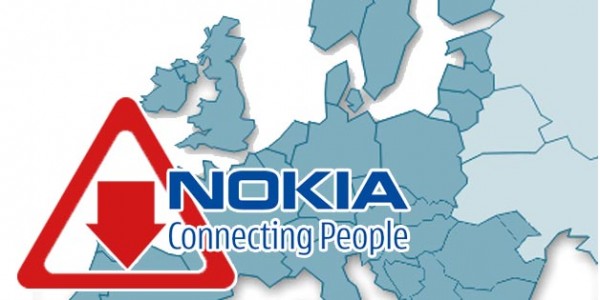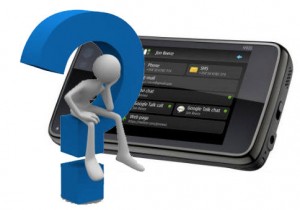Elop is delusional? – Tomi Ahonen thinks so

In keeping with his usual blogging tendencies, Tomi Ahonen over at Communities Dominate Brands has written another multi-thousand word post, this time focusing on his analysis of Stephen Elop’s behavior and choices since becoming Nokia CEO late last year. Now in my cursory reading of his post I find myself agreeing with a few of his points, while strongly disagreeing on others.
The following numbered points I found myself agreeing with wholeheartedly:-
1. Nokia at the time of the burning platform memo were still statistically the leading manufacturer of regular mobile and  of smartphones in the world and that OS-wise Symbian still held a SLIM (and decreasing) majority. It still leads in installed base numbers as well for obvious reasons.
2. Nokia has by and large had hardware features (some software related) that others, OEM’s and software houses included, didn’t implement until many years later.
3. The US is not the center of all mobile innovation, those regions would be in eastern Asia namely Korea and Japan.
Caveat: Most of those innovations tend not to take off in other markets. Nevertheless, the US market is currently driving mobile “innovation” in almost all other markets.
4. The US cellular market is behind many European markets and networks in terms of inter-carrier relations and tower-sharing. Quality of service and speeds of 3G and 3G+ speeds (I refuse to call things like HSPA+ 4G) are below par and thus the US market is irrelevant.
5. There were certain “factual errors” in the burning platform memo that somehow decrease his credibility in all other aspects and responsibilities.
6. Nokia were working on building a substantial ecosystem through their work with Qt, Intel and the Linux Foundation on their Maemo and eventually MeeGo platforms.
7. Nokia has substantial R&D assets that it should NOT rid itself of if it wishes to be a success in the future (this is looking past their efforts with Windows Phone 7)
8. The US market is but a miniscule percentage of all mobile phone usage and subscribers.
9. Elop’s announcement of Symbian’s death may have been a mistake and/or a REALLY bad idea. (I hesitate to use stronger language because I doubt a man of his experience, business acumen and foresight would do such a thing without valid reason, whether that reason is in Nokia’s best interests is up for discussion)
10. The Ovi Store was growing significantly and was by and large a profitable endeavour for developers and Nokia if only by virtue of the size of the  target market.
Now all of the above are more or less facts, or at least very widely held opinions (whatever little that means) but in spite of all the above I can’t help but disagree with the general message of the post. I know full well I’m liable to be slated for all of this but here are my views on the above points as well as a few more made in Tomi’s post.
1. Yes the Burning Platform memo may have had a few inconsistencies with statistical data. However, the general message especially in terms of perception by the general public holds true. Apple’s iPhone and Google’s high-end Android devices are innovative and bleeding edge in the eyes of the general populace. Sure that may not be true, but if the public believes it and the public wants it, the public buys it. Guess who loses? Nokia. It’s as plain a truth as any.
Statistically, Symbian and by proxy Nokia, no longer hold the #1 position in terms of shipments of devices belonging to a single ecosystem. That crown now belongs to Google and Android. The same Android that I made the following remark about just a few hours ago.
“Android by and large is what Symbian could have been, ubiquitious, powerful and open…alas”
A statement I will stand by regardless of  criticism.
Many will point to the Feb 11th announcements as having had significant effects on the sales of Symbian devices and you’d be right. They’ve had a remarkably detrimental effect on sales. However, the writing’s been on the wall for nearly a year now with steadily decreasing marketshare in both the mobile phones and smartphones segments with SIGNIFICANTLY slower growth than the top competitors AND the market in general with regards to the smartphone segment. (Which also happens to account for a healthy percentage of Nokia’s profits it must be said.)
Nokia has also been downsizing massively, (closing its flagship stores, closing offices, outsourcing other things.) Â in the past few years to save costs while some of it’s competitors have been posting record profits, growth, future earning potential, stock value and much more while not cutting back at all. That on the back of a smartphone strategy that highly relied on the Symbian platform.

Lower growth
Worse still is the fact that Symbian^3 simply isn’t selling as well as hoped. We’ve seen multiple figures quoted for that family of devices but it’s generally accepted to be about or slightly below 10 million devices sold in ~4-8 months of availability. To put this into stark contrast, lowly Samsung sold that many Galaxy S family of devices in under 6 months of availability. Apple as well showed significant sales as well in the past few quarters selling upwards of 4 Million new iPhone4’s in the same time period on a SINGLE carrier. Nokia has recently ceded leadership over Western Europe’s smartphone market to Samsung. These are ALL telling signs, you don’t sell the same number or less than your competitors when you used to be the market leader and simply shrug. It’s a problem, the market just doesn’t seem to want your products as much anymore.
2. Nokia was putting devices with 5 megapixel cameras, VGA recording, hotspot and tethering capabilities, accelerometers, bluetooth file transfers, application stores and downloads, multitasking, NFC, integrated GPU’s and a myriad of other features and capabilities that are just now making their way into the mainstream market. That’s before considering some of the more software related milestones Nokia had achieved. The sad thing is, some of these same achievements were lacklustre in their implementation and or simply dumped in later devices; occasionally without good reason for having done so. At other times, the powers that be decided that consumers didn’t want or need them only to see their competitors taking advantage of those same consumers who’d previously been making solid use of said features.

The pinnacle
3. Sure the US is not the center of mobile innovation, in spite of what others may try to say to the contrary (Elop included) that said, the most successful software companies in the world certainly originate there. The most valuable software/hardware company in the world is certainly based there as well. Sure the “innovations” there are less than original but the public thinks they are and as mentioned before, that’s all that really matters. Matters not who gets their first, it’s who does the best work and managed to monetize the innovation that benefits.
4. Yes traditionally, the US market has lagged behind in terms of deployment of every iteration and improvement of 3G. Yes the quality of the service is below our European compatriots and yes the prices are remarkably unfair but in spite of all that, the country with the largest deployment of LTE in a mobile carrier setting is….. the USA. Coupled with the fact that the US market represent but a miniscule percentage of the overall mobile subscriber population but their smartphone adoption rates are higher than the norm. Furthermore it’s the common belief that cracking the US market is hard, damned hard as Nokia have shown. That said, if one can penetrate that market, in all likelihood you can conquer all markets due to the choosiness of the consumers there weeding out shortcomers.
5. Tomi everyone makes mistake in their writing. Might have come across as an utter loon to Nokia employees then, but he looks a right deal of a visionary now, in spite of his help in making that truth come to pass :P.
6. The Qt, Maemo and Intel ecosystem had potential for great success. However, Intel has yet to get a mobile processor on the market and won’t have one for another year or so, they have no design wins and Moblin was a deadweight. Merging Moblin with Maemo slowed the latter’s development significantly and delayed the release of any Nokia products that were supposed to be running their Maemo 6-Harmattan OS. With no other partners seriously interested in MeeGo besides the two founders, little major development house adoption of Qt-based mobile strategies and the existing entrenchment of iOS and Android, it is possible, very possible that Nokia feared another WebOS situation. That is, a situation where in spite of being a viable option for multiple GOOD reasons, it’s nigh-impossible to get the critical mass required to gain developer traction and thusly consumer interest and demand.
7. Nokia would be idiotic, and it mean this in the strongest way possible, to cast aside their formidable research and development assets. In particular, their cellular & RF Â engineering, materials research, electrical engineering, imaging and related engineering talent & power management expertise. All of which should be kept. Further they should be looking forward and exploring new technologies and usage paradigms for mobile devices and working to pioneer those future disruptions, something Elop appears keenly aware of with the “future disruptions” pillar of his strategy for Nokia.
Consider his perspective for a minute; Industry pioneer and leader has their technological prowess questioned and their leadership position both in the minds of the consumer and in terms of revenues and volume wrested from their control by disruptive newcomers. The disruptive technologies strangely enough begin in emerging markets as opposed to developed markets where the major players are already entrenched. Further these disruptive technologies while initially only managing to cover the most basic use cases, grow at a remarkable rate compared to competitors eventually covering all the existing use cases.

Disruption
Sound familiar to you? The iPhone and the emergence of Android are PERFECT examples of such an occurrence in the present day.  Persisting with existing technologies by the incumbents eventually means slower growth over time and eventually their replacement and/or relegation to lower use cases. See Christensen’s “Disruptive Technologies: Catching the Wave” for more information on this concept.
This theory likely prompted Elop to relegate Symbian’s significance and the subseqent culling of what he and likely the board agreed were “older” technology in the hopes of building something new, innovative and disruptive to recapture the market. For the time being, Windows Phone 7 could present that sort of disruption but in any case I don’t doubt work is continuing past this and exploring other avenues.
8. Qt and the Ovi Store may be axed in the future but they are neither down or out. Cross platform and/or platform independent technologies are the way forward, end of. Locking developers into a single platform may help to grow the platform or it may serve to kill it depending on market swings. However, with the growing number of devices, platforms and markets to localize for, developers are likely having an increasingly difficult time addressing all remaining platforms. Clearly the two juggernauts (Apple and Google) currently control the market with their separate and incompatible platforms, each with their own set of issues. Nokia with Qt as their weapon were attempting to disrupt the disparateness of platforms in this fashion, this issue with such an approach is the lack of cooperation of the respective companies regarding documenting exact changes and of course willingness to divulge future plans for their platform with competitors. It simply would never work outside of Nokia. On top of this there were already signs of certain issues with Symbian even slowing the development of Qt on other platforms or at least preventing the use of certain API’s until problems were fixed. Imagine the clusterf*** that would have resulted if you added other OS’s to the mix. Whether Nokia’s development efforts on the Qt front will mirror my (and many others’) ideals remains to be seen, but their commitment to maintaining the development of the platform bodes well for Elop’s ideas that certain aspects of Nokia R&D are worth keeping.

I’ve said all of the above and more that I may have mentioned on my twitter to say this. Sure he has had missteps in particular regarding the February 11th events and POSSIBLY (we’ll know in a few months) in siding with Microsoft regarding their smartphone strategy but the wheels had fallen off the wagon WELL before he got there.
He may have cut the fuel lines with his announcement but it remains to be seen whether cutting those lines prevented a crash and an almighty blaze of failure that would have otherwise resulted if they’d continued on their current path of willful ignorance and bad decisions (which seemed inevitable to me ) or simply sped up the demise of the company as a whole by putting even more fuel into the impending blaze. In any case, by and large his decisions have seemed  logical to me; even if his lack of experience of the mobile market may seem obvious to many.
Elop isn’t delusional Tomi, he simply made the hard decisions(misguided though it may be), be disruptive; be bold and suffer the  possible consequences or be overtaken and left behind .
The CEO’s of RIM have done the opposite of Elop and I’m pretty sure they’re in no way better off for it (maybe even worse) and with no relief in sight, I’d vouch for them being defunct sooner rather than later.
P.S. For some opinions on what (former) RIM supporters think of their current situation and the parallels with Nokia check out this BGR article. Note, BGR was a massive RIM site back in the day.
Category: Nokia






Connect
Connect with us on the following social media platforms.